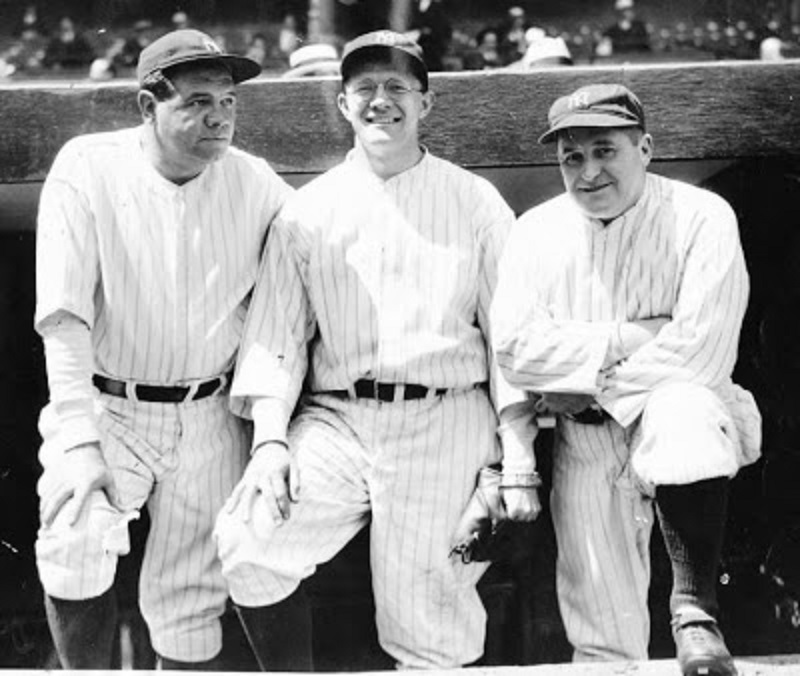Baseball History Comes Alive Now Ranked #2 by Feedspot Among All Internet Baseball History Websites and Blogs!
Guest Submissions from Our Readers Always Welcome!
Subscribe to my blog for automatic updates and Free Bonus Reports: “Memorable World Series Moments” and “Gary’s Handy Dandy World Series Reference Guide.”
Joe McCarthy Photo Gallery
Click on any image below to see photos in full size and to start Photo Gallery:
- Boston brain trust: Larry Woodall, Paul Schreiber, Earle Combs, Joe McCarthy, Del Baker
- Joe DiMaggio with manager, Joe McCarthy, Spring training, 1936
- Lou Gehrig and Joe McCarthy
- Joe McCarthy and Casey Stengel
- Babe Ruth, Johnny Broaca, Joe McCarthy
- Managers Charlie Grimm and Joe McCarthy, 1932 World Series
- Manager Joe McCarthy congratulates Joe DiMaggio after his 56-game hitting streak ended, July 17, 1941. I can make out Joe Gordon on the left, Art Fletcher behind DiMaggio, Buddy Rosar in catcher’s gear, and probably Earle Combs behind McCarthy.
- Joe McCarthy with one of his Yankee successors, Hall-of-Famer Bucky Harris.
- Lou Gehrig, Carl Hubbell, Christy Walsh, Joe McCarthy, 1936 World Series
- 1941 World Series:New York managers, Leo Durocher and Joe McCarthy, 1941 WS
- Joe DiMaggio with manager Joe McCarthy
- Classic Charles Conlon portrait of Joe McCarthy
- Manager Joe McCarthy and coach Jimmy Burke, late 1920s
- Tony Lazzeri with manager Joe McCarthy
- Lou with manager Joe McCarthy. In his speech, Lou called McCarthy “The greatest manager in the game today.”
- Manager Joe McCarthy and Cub owner William Wrigley on the right
- Baseball Hall of Hame in Cooperstown, NY in 1959. Left to right’Home Run’ Baker, Ty Cobb, Zack Wheat, Frankie Frisch, Joe McCarthy, George Sisler, Pie Traynor.
- Joe McCathy and Ted Williams during the 1948 season (Getty Images0
- Joe McCarthy with Del Baker (Boston Public Library collection)
- Celebrating the 1937 World Series victory with Joe McCarthy, Col. Ruppert, Joe DiMaggio, Lou Gehrig, and Tony Lazzeri
- Joe Cronin and Joe McCarthy
The Joe McCarthy Era Begins in New York!
“…The square-jawed little Irishman from Buffalo, New York won more World Series championships than John McGraw and Connie Mack.” –Sportswriter Arthur Daley, speaking of Joe McCarthy
Eighty-six years ago today, April 13, 1931, Joe McCarthy made his debut as Yankee manager, beating the Red Sox at Yankee stadium, 6-3. That was the beginning of one of the most successful runs in baseball history. In 16 seasons at the Yankee helm, all he did is go 1460-867 (.627) with eight pennants and seven World Series championships. And all this came after a pennant with the Cubs in 1929, their first in eleven years.
In the featured photo, we see Babeb Ruth and Joe McCarthy. But who’s the player in the middle? Want to take a guess? The answer is at the bottom of the post.*
McCarthy’s success over 24-seasons ranks him as one of the greatest managers in baseball history. He’s “number one” in many significant categories, including holding the highest winning percentage during both the regular season (2125-1333, .615) and post-season (26-13, .667), and was the first manager to win pennants in both the National and American Leagues. In a total of 32 years managing in the major and minor league level, his 1922 Louisville club was the only team to finish either with a losing record or below fourth place.
McCarthy cited “heath reasons” for his resignation as Yankee manager three months into the 1946 season, but there were also persistent rumors that he resigned due to a personality conflict with the volatile new Yankee president, Larry MacPhail. After two years out of baseball, McCarthy was hired by the Red Sox for the 1948 season after they had finished 14 games behind the Yankees in 1947.
McCarthy continued his winning ways in Boston, compiling a remarkable 229-145 (.606) record. Although he failed to win a pennant in Boston with two heart-breaking second place finishes, he came awfully close. In 1948, his Red Sox finished in a tie for first with the Indians, but he lost a one-game playoff to the Tribe; and in 1949, he lost the pennant in the final weekend of the season to the Yankees. Ted Williams felt the two emotionally draining second place finishes took the heart out of McCarthy, adding “He finally quit during the ’50 season, I think, out of his own extreme disappointment.”
Some detractors believed Joe McCarty’s success was simply due to being fortunate enough to have talented teams. He was once described by White Sox manager Jimmy Dykes as a “push-button” manager. Yet McCarthy was an outstanding teacher and developer of talent, and was particularly adept at handling temperamental players such as Hack Wilson, who thrived under McCarthy’s direction, and Babe Ruth. After McCarthy left the Cubs, Hack Wilson’s career decline began and he was never again the same player.
Joe McCarthy, unquestionably one of the greatest managers in baseball history, died of pneumonia at the age of 90 on October 13, 1979. He was elected to the Hall of Fame by the Veterans Committee in 1957.
*The player in the middle is pitcher Johnny Broaca, who joined the Yankees on June 6, 1933 out of college after being suspended by Yale varsity coach, “Smoky Joe” Wood.
Visit Our Web page: “Baseball History Comes Alive!
http://wp.me/P7a04E-2he
Gary Livacari
Photo Credits: All from Google search
Information: Excerpts edited from the Joe McCarthy Wikipedia page.
We are a participant in the Amazon Services LLC Associates Program, an affiliate advertising program designed to provide a means for us to earn fees by linking to Amazon.com and affiliated sites. Click here to view Amazon’s privacy policy






















